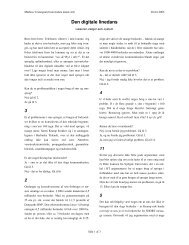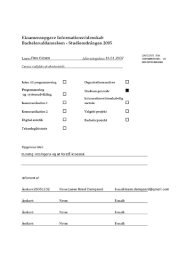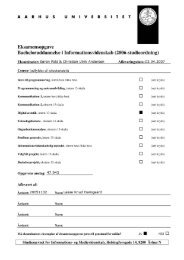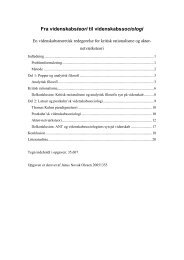Semiotics, Fashion and Cognition - Mathias Vestergaard Corp.
Semiotics, Fashion and Cognition - Mathias Vestergaard Corp.
Semiotics, Fashion and Cognition - Mathias Vestergaard Corp.
You also want an ePaper? Increase the reach of your titles
YUMPU automatically turns print PDFs into web optimized ePapers that Google loves.
<strong>Mathias</strong> <strong>Vestergaard</strong> Jakobsen <strong>Semiotics</strong>, <strong>Fashion</strong> an <strong>Cognition</strong> 2008-06-11<br />
instance the schematic distinction between tight-fit <strong>and</strong> loose-fit, is often ignored by native English<br />
speakers because this distinction is not used in the language.<br />
Section C. Cognitive fashion theory<br />
As we have seen in the previous section, the cognitive language tradition provides a new view on<br />
language, focusing on embodiment <strong>and</strong> the bodily experience, framing <strong>and</strong> images schemas. In this<br />
section we will explore the consequences of this emerging view, with regards to fashion as a<br />
language.<br />
In this paper I presented Barthes’ theory in two parts: first his overall view on historical<br />
developments of signs in clothing communication, second his view on how fashion magazines<br />
through written garments, create fashion in the narrow sense. To revise Barthes’s first view I will<br />
look at how communication in physical clothing might work in a cognitive perspective. To revise<br />
his second view, I will first examine the overall constitution of what creates the experience of<br />
fashion (in the narrow sense) <strong>and</strong> later explore the language of fashion magazines <strong>and</strong> fashion<br />
language in general.<br />
Communication in clothing<br />
In the cognitive tradition, Saussure’s distinction between langue <strong>and</strong> parole is no longer of much<br />
interest. It should be evident from the previous section that the focus here is on language use. An<br />
abstract idea of a shared system of meaning can only be seen as a structure emerging from the use,<br />
but it does not hold any normative power over future utterances. Similarly we might have to<br />
ab<strong>and</strong>on Barthes distinction between dress <strong>and</strong> dressing. But what will take its place?<br />
As we saw in the previous section, even our simplest utterances (“a great deal on buying shoes<br />
online”) require vast amounts of background knowledge (of commerce) organized in frames <strong>and</strong><br />
activated by the words, in order to arrive at a suitable interpretation. Looking at clothing from a<br />
communicative point of view, it should be evident that physical garments have a relatively low<br />
semantic meaning in <strong>and</strong> by itself. A white t-shirt – independent of the experiences one might have<br />
had with white t-shirts – does not hold much meaning by itself, except that it is probably clean<br />
(<strong>and</strong> if it is not, it shows immediately). In this sense, a garment or an outfit is an even simpler<br />
utterance.<br />
My proposal is that the same principle of activated background knowledge through framing, as<br />
discussed in language, also governs clothing communication. When we see a particular garment,<br />
someone in a certain outfit, or a certain way of wearing a garment, we automatically activate the<br />
relevant background knowledge as frames. This does not give us any clear or concise message –<br />
there is no agreed interpretation that blue jeans are equal to “I’m off from work”, or that a pair of<br />
cowboy boots means “I can ride a horse <strong>and</strong> throw a lasso”. Instead we get an incongruent mix of<br />
ideas <strong>and</strong> experiences, since many frames might be activated by the same outfit. A guy in blue jeans<br />
<strong>and</strong> a white t-shirt with the sleeves rolled up might remind us of a cover from a Bruce Springsteen<br />
album or a guy from the “Beverly Hills 90210” TV-show, similarly a trench coat might remind us of<br />
Sherlock Homes or Eastern Germany Stasi-employees (depending on how the coat is buttoned).<br />
Frames compete, <strong>and</strong> needless to say, it is highly variable between individuals which frames will<br />
Side 9 af 17








